Preflop Poker Guide: Hands to Raise From Each Position
If you missed it, I suggest reading my Introduction to Game Theory in Poker article.
The ranges I’m presenting in this blog are what I use as my baseline preflop opening strategy when playing no limit hold’em cash games.
This does not mean they are perfect and that you shouldn’t adjust the ranges to both your style of play and the game you are in. I adjust how and what I play based on the table I’m at, but this is my general strategy before knowing what type of game I’m in.
For instance, if you are playing in a weaker live game in a casino without aggressive opponents, then you might want to raise more hands than I suggest because more hands will be profitable against players who enter pots with far worse hands than expected and you don’t have to worry about players reraising and forcing you to fold hands. Sometimes you may even want to limp, thinking that it is more profitable in your specific game than other games. If people are willing to call big raises maybe you want to 5-6x instead of 3x in your games so that you can get lots of money in with strong hands. On the flip side, if you are playing in an extremely aggressive game where people put in money very bad, you might want to play tighter than I suggest, waiting for good hands and taking advantage of opponents that won't notice you're playing only premium hands.
The decision of what hands you play and what raise size you use is up to you. For this blog I assume the table is roughly 100 big blinds deep effectively, there is a small blind and big blind forcing the action, and there are no antes. Other table setups will have different baseline ranges.
As a baseline strategy, I suggest raising 3 times the big blind from first to act until the cutoff, 2.5 times the big blind on the button, and limping the small blind when you want to continue there. Do not limp in other positions and don’t vary your raise sizes with different holdings, keeping the same size with each hand for balance and deception purposes.
edit: I have included a SB raising range, as that option is likely to be more profitable in many games you play. I still prefer using the limping strategy as a baseline, but many players in the BB will be making enough mistakes that raising to 3x is better, so I included that range below.
edit2: I have also included one attempt at GTO strategy from the small blind, and it is extremely complex. It allows you to play more hands from the small blind than you can when raising only, but less hands than you can when limping only, but is definitely the more accurate solution.
Take my advice with a grain of salt
I’ve played poker professionally for 10 years, but nowadays I play mostly Pot Limit Omaha and I was never the very best NLHE player in the world, nor do I use the most advanced poker game theory solving software to help create solutions. These ranges are solid, but better and more precise ranges do exist. However, these are a good starting spot for most people who play poker.
Under the Gun (First to Act Preflop)
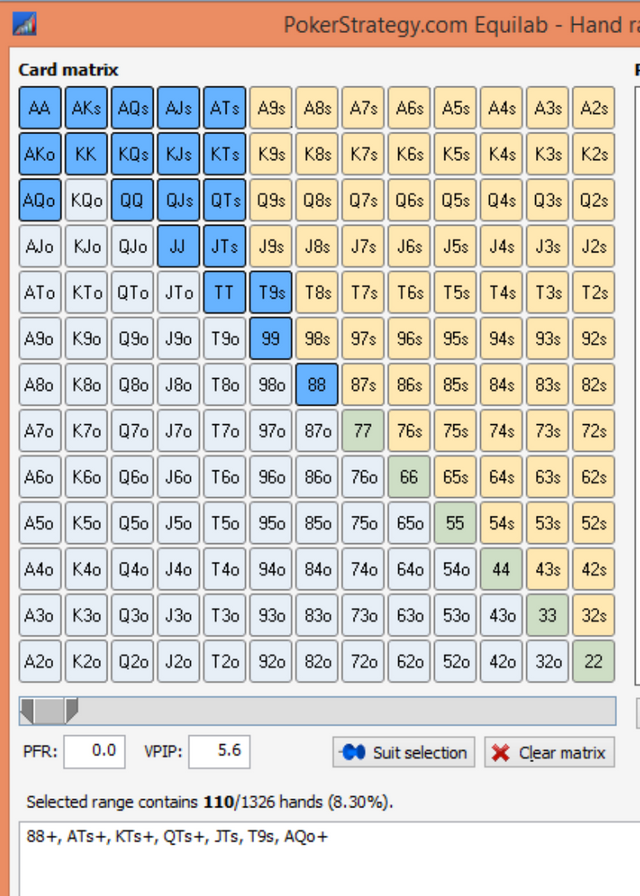
Raise to 3bb with 8.3% of hands: 88+, ATs+, AQo+, KTs+, QTs+, JTs, T9s
We want to play tight first to act because there are 8 players behind us who could wake up with very strong hands. I suggest raising 8.3% of hands UTG. This way when someone reraises, you can continue with strong hands and not have to worry about either overfolding to raises or continuing with weak hands.
This range contains a lot of suited high cards, which both block other people at the table from having big pocket pairs due to card removal (the strongest hands in poker and the most likely hands to reraise us), but also flop very well. Even when they miss the flop, we can often continuation bet due to the ability to turn outs. For instance imagine having QTs on an A93 board with one of our suit. We can win the pot with a cbet, but if we are called and the turn comes either a king, jack, or eight of our suit, we can continue betting our flush and straight draw alongside our top pairs or better.
Note that this range does not contain many pocket pairs. Although they can make extremely strong hands when they flop a set, this only happens roughly 11.8% of the time. In the 88.2% of the time when the small pairs don’t flop a set they are usually in bad shape against boards that have overcards. They also have little change to improve with only 2 outs to make the set on a future street, making them bad candidates to bluff.
Under the Gun+1 (Second to Act)
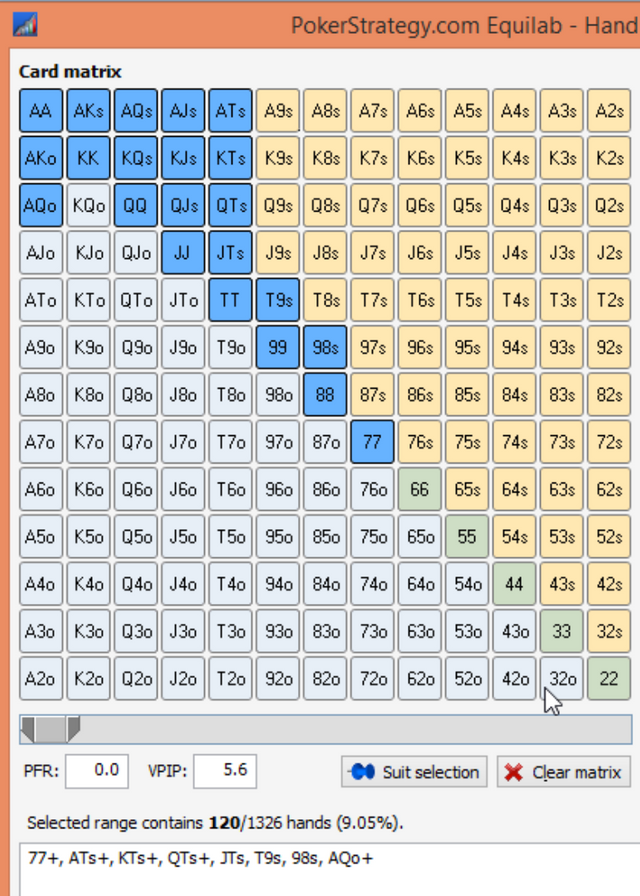
Raise to 3bb with 9.05% of hands: 77+, ATs+, AQo+, KTs+, QTs+, JTs, T9s, 98s
This range is similar to UTG with the addition of 77 and 98s. Our range will progressively get wider as less players are left to act behind us.
Under the Gun+2 (Third to Act)
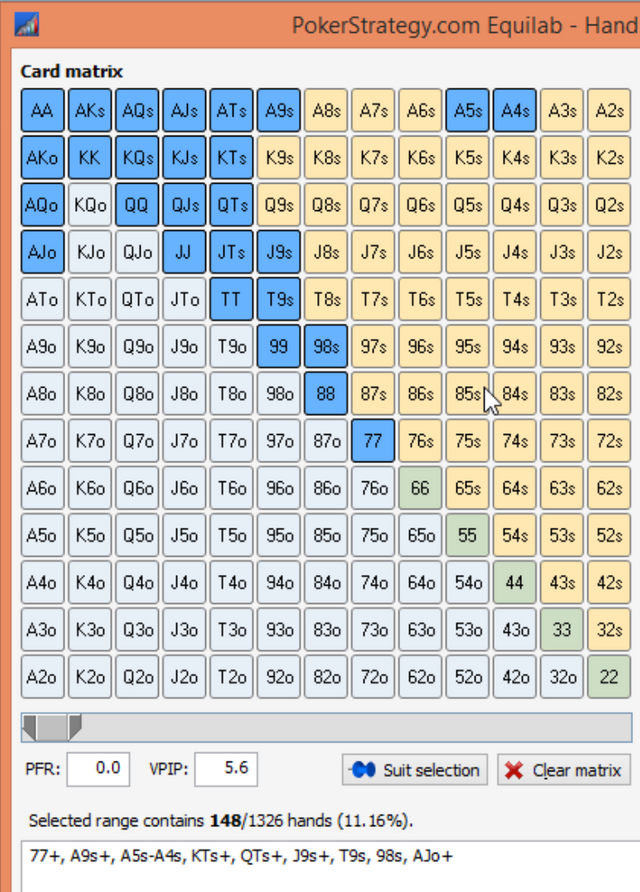
Raise to 3bb with 11.16% of hands: 77+ A9s+ A5s A4s AJo+, KTs+, QTs, J9s, T9s, 98s
We add in A9s, A5s, A4s, AJo, J9s to the UTG+1 range. At first glance, the A5s and A4s hands are particularly puzzling being that we don’t raise A6s-A8s. First off, these hands are more likely to make a straight, and if we flop a gutshot straight draw we can bluff multiple streets so they are better than A6s-A8s.
Additionally, if we get 3bet, we can use A4s and A5s in conjunction with AA and KK to 4bet a balanced range. It’s great to 4bet hands with an ace in them because they block our opponent having AA or AK (two strong hands that will continue), and using hands that can additionally flop gutshots and flush draws work very well.
Lojack (Fourth to Act)

Raise to 3bb with 15.38% of hands: 55+ A2s+ AJo+ K9s, KQo, Q9s, J9s, T9s, 98s, 87s
We add in 55-66, the remainder of suited ace hands, KQo, K9s, Q9s, and 87s. By now you can see the pattern of adding in additional pairs alongside the best suited cards, beginning with the connected broadways and suited connectors. These hands are the most likely ones to hit the flop and have lots of equity against opponent calling ranges.
Hijack (Fifth to Act)

Raise to 3bb with 17.65% of hands: 44+ A2s+ AJo+ K9s, KJo, Q9s, J9s, T8s+, 97s+, 87s, 76s
We add in 44, KJo, T8s, 97s, 76s from the lojack position. Some players also add in ATo, but I find we have more than enough broadway hands and it flops a little worse than the other hands we add in so I choose to fold it.
Cutoff

Raise to 3bb with 24.89% of hands: 22+ A2s+, ATo, K8s+ KTo, Q8s+ QTo, J8s+ JTo, T8s+, 97s+, 86s+, 76s, 65s, 54s
We will in more hands the same way we have been. This range is seemingly pretty tight from the cutoff, but we don’t want to be too wide because then the button can start reraising relentlessly. Having a 25% range allows us to continue with a large portion when 3bet.
Button
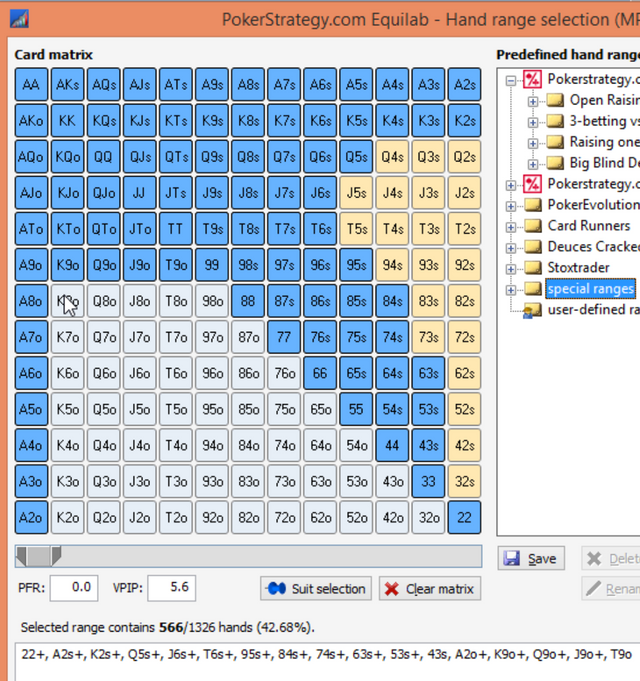
Raise to 2.5bb with 42.68% of hands: 22+ Ax+, K2s K9o, Q5s Q9o, J6s J9o, T6s T9o, 95s, 84s, 74s, 63s, 53s, 43s
First thing to note is that I recommend raising to 2.5bb here rather than 3bb. We have position for the rest of the hand against the small and big blinds, and by raising smaller we keep the effective stack sizes deeper, thus increasing our positional advantage.
Back in the day, most professionals used to raise well over 70% from the button. Players in the big blind folded far too frequently and in general the blinds did not reraise enough. Nowadays, most people reraise roughly 15% of hands from the small blind and the big blind defends very wide against raises, making many previous open raises unprofitable.
As explained in the Introduction to Game Theory blog, we don’t want to overfold to reraises and probably need to defend roughly 50% of our opening range.
Sample continuing range:
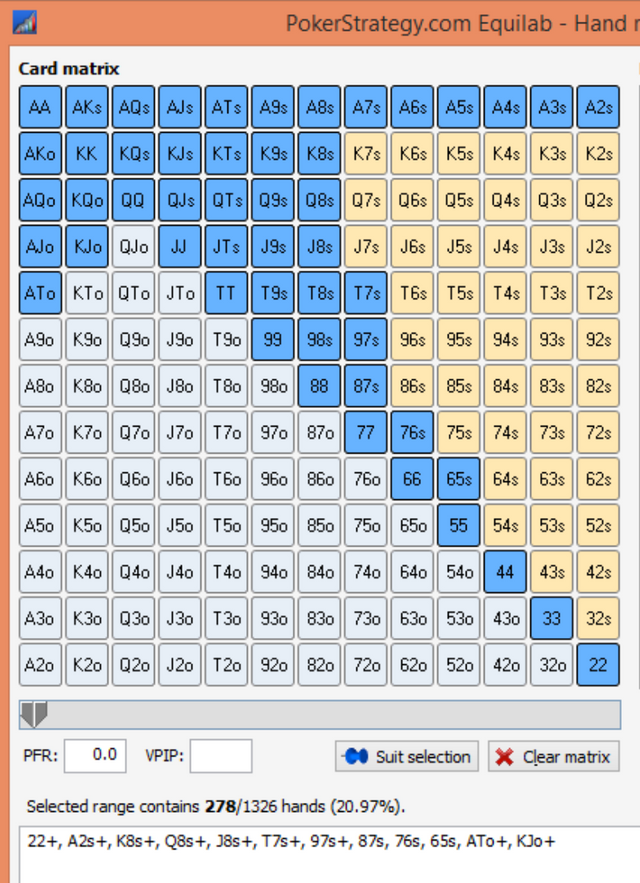
This might seem wide to you, but these hands both flop well and have pretty strong equity against top 15% of hands. For instance, KQo is 46.21% against the top 15% of hands and has position, making it a pretty easy call getting nearly 2:1 odds. You probably don’t want to call every hand that has direct equity because some hands won’t realize their equity as well as others (for instance A8o has decent hot and cold equity but will almost never flop well). If this seems wide, imagine how wide the range would have to be to be able to raise much wider from the button.
Small Blind Lines
I will present 3 possible ways to play the small blind. The first is how I approached it in the past, as it was an easy way to do things. The second is a raise only range that is a more exploitive strategy aimed at taking advantage of opponents who overfold or play poorly postflop. The third is a free preflop guide provided by pokersnowie, a poker bot that attempts to find GTO plays, and is what I think is a much closer to correct solution than the first or second, but is very complex.
Small Blind Range 1: Limping Only

Limp with 63.20% of hands: 22+, Ax, K2s, K3o, Q2s Q5o, J2s, J7o, T2s T7o, 94s 97o 84s 87o, 73s, 62s, 52s, 42s, 32s
I will save the justification for limping this range from the small blind for my next blog, because it is a long explanation. But the basic idea is that you already invested the small blind and are getting 3:1 odds so you want to play a lot of hands, but raising only your strong hands while limping the weak ones is a face up strategy, so it’s better to limp your entire continuing range. The big blind can’t really punish this strategy either, raising more than 25-30% of hands is not advisable due to the presence of all big pairs in our range and our ability to limp reraise.
SB Range 2: 3x Raising Range
In many games your EV will be higher raising from the SB than limping. Some BB overfold and you will simply win money by raising frequently. Other BB will call preflop and overfold to flop cbets. @bacchist is a former professional poker player and doesn't like my limping strategy: he prefers a raise first in from the SB as well, so I'm including the range I would raise from the SB:
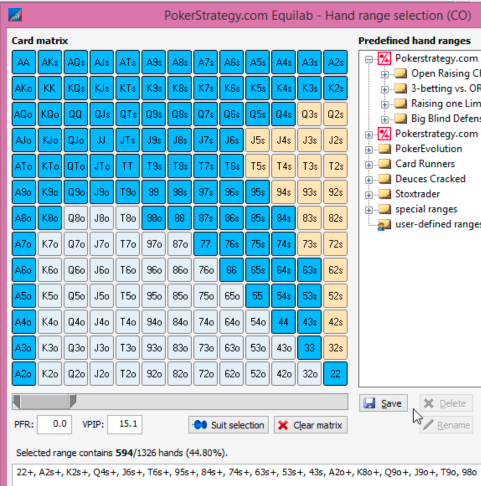
It's a little counter-intuitive that the SB raising range would be wider than the button raising range given the SB is out of position the whole hand, while the button is in position. But there are three reasons for this. The first is that the button has to contend with 2 players having hands while the SB is only facing one opponent, so when the button raises the SB can additionally 3bet him out of the hand as well as the BB. The second is that the SB has half a big blind invested already and has incentive to raise--by raising to 3x he will risk 2.5bb to win 1.5bb just as the button did. The third is that despite risking the same amount for the same reward as the button, the SB gives the BB worse odds: the button gives him 2.67:1 while the SB gives him 2:1. These three factors are probably enough to negate the positional disadvantage from the SB to justify raising a similar percentage of hands.
If the BB 3bets, the SB has options such as shoving all in with small pairs and a few other hands to retain their equity and avoid difficult spots postflop. He can also call with the middle of his range, and 4bet small with a polarized range consisting of strong hands like 77+ AJs AQo and suited hands just too weak to call 3bets like 86s, 97s, T7s, J8s, Q8s, K6s-K7s. Overall he should be able to come up with a way to defend roughly 22% of hands vs a 3bet.
Sample continuing range against BB 3bet:
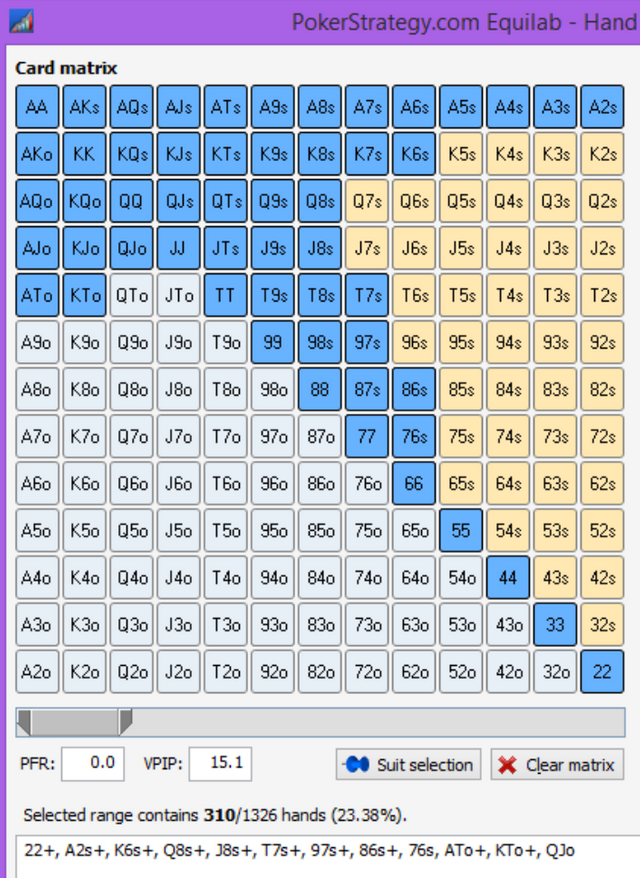
Mixed Strategy -- GTO Solution
This isn't a perfect GTO solution, but it's a much more accurate one than either the pure limping or pure raising strategy. It recommends raising sometimes and limping sometimes with both ranges balanced, containing strong and weak hands and both ranges having hole card coverage so they hit all kinds of board textures.
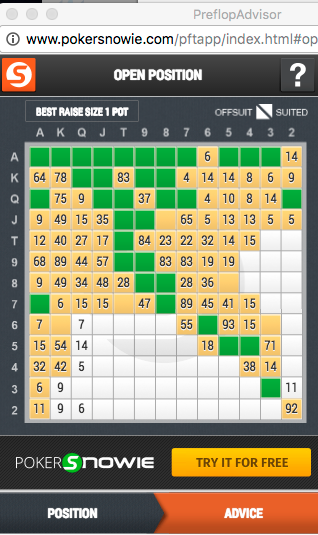
source: PokerSnowie Free Preflop Guide
Green means raise, yellow means call, yellow with writing means raise that % of the time and call the remainder. As you can imagine this is a pretty hard chart to follow, trying to raise certain hands a certain % of the time is difficult for humans that are bad at randomization. One trick I used was to randomize by suit. You can round each number to it's nearest 25% and raise 1 specific suit for 25%, 2 for 50%, 3 for 75%, all 4 for 100%.
But all in all, this strategy recommends raising roughly 20-25% from the sb and limping another 30-35%.
Listed Together
UTG: 8.3%: 88+, ATs+, AQo+, KTs+, QTs+, JTs, T9s
UTG+1: 9.05%: 77+, ATs+, AQo+, KTs+, QTs+, JTs, T9s, 98s
UTG+2: 11.16%: 77+ A9s+ A5s A4s AJo+, KTs+, QTs, J9s, T9s, 98s
Lojack: 15.38%: 55+ A2s+ AJo+ K9s, KQo, Q9s, J9s, T9s, 98s, 87s
Hijack: 17.65%: 44+ A2s+ AJo+ K9s, KJo, Q9s, J9s, T8s+, 97s+, 87s, 76s
Cutoff: 24.89%: 22+ A2s+, ATo, K8s+ KTo, Q8s+ QTo, J8s+ JTo, T8s+, 97s+, 86s+, 76s, 65s, 54s
BTN (2.5x): 42.68%: 22+ Ax+, K2s K9o, Q5s Q9o, J6s J9o, T6s T9o, 95s, 84s, 74s, 63s, 53s, 43s
SB (3x range): 44.80%: 22+ Ax+, K2s K8o, Q4s Q9o, J6s J9o, T6s T9o, 95s, 84s, 74s, 63s, 53s, 43s
SB (limp): 63.20%: 22+, Ax, K2s, K3o, Q2s Q5o, J2s, J7o, T2s T7o, 94s 97o 84s 87o, 73s, 62s, 52s, 42s, 32s
As said at the top, these ranges will change depending on the table dynamics, and the game you’re in. For instance in tournaments with antes, I would raise wider from every position. The same goes for cash games with loose passive players. Adjust this hand chart as you see fit.
My name is Ryan Daut and I'd love to have you as a follower. Click here to go to my page, then click  in the upper right corner if you would like to see my blogs and articles regularly.
in the upper right corner if you would like to see my blogs and articles regularly.

I am a professional gambler, and my interests include poker, fantasy sports, football, basketball, MMA, health and fitness, rock climbing, mathematics, astrophysics, cryptocurrency, and computer gaming.
Will you be posting about pot limit omaha? Much more room to improve over the small stakes competition. 90% of the small stakes are playing four-card holdem! ha. Ill poke around your page now instead of asking a stream of questions.
I originally wanted to make a complete preflop guide with calls and 3bets, but to this day I've never figured out a great way to create optimal calling ranges. It requires so much calculation that I think most top players just sort of guess what's profitable, but I've never seen rigorous answers.
To the other players out there, how do you come up with preflop calling ranges? (in spots other than the big blind).
Here's one particular instance I'm curious about answers on:
Lojack opens (with the 15.38% range I gave above), what do you call and 3bet in the cutoff?
The best calling ranges I have found were in Matthew Janda's book... They are part of a full GTO strategy (to the extent that it is possible to approximate one!) and as such, it is not hard to craft balanced ranges for any given flop.
I read his book back in the day and I didn't really agree with his ranges. Thought there were a couple spots he was calling way too wide (down to 54s in some spots with players behind). That said I had no way to show my ranges were better haha. Only real way is for someone like nanonoko with a few million hand database to chime in with his empirical results, but it's always been the area where I beat my head against a wall and could never justify answers.
The thing with 54s and similar hands is that they retain their equity very well on many flops. It's very easy to construct robust ranges with a hand like 54s.
wow! people will make use of this hehe.
I have to admit that I totally disagree with this. But I'm willing (even excited!) to hear your explanation. I am looking forward to your future post.
I used to hate it too, and against many players that overfold it's better to 3x a very wide range. Maybe I've been clouded because it's even better in tournaments (ante games almost require limping continuing range over raising), but I've found it's the better GTO strategy for small blind than raising a low % of hands and folding away your sb too frequently.
I suspect the real solution is a mixed strategy of raising/limping, but it's really hard to balance those ranges this deep OOP, so I chose to limp everything instead.
Against players that over-defend it is better as well! When you 3x a good range from the SB, you will be in a great position against many players. A lot of players will defend far too wide, because they always suspect a steal and they don't want to be bullied. They defend against SB opens as if the SB opening range was as wide as a button opening range... and then they continue on far too many flops.
But please, let me just say how glad I am to be able to discuss poker on this level here on Steemit. It is a breath of fresh air! I'm very grateful for your contributions.
Of course, constructing ranges for out of position flop play is a difficult task. But if you have a better range to begin with, you have a little bit of a greater margin of error.
If you choose to raise from the SB, I think the range should be wider than the button open -- assuming the SB 3bets his continuing range vs a button open, the button is already at a disadvantage of only getting through 85% to the bb, and the positional advantage likely isnt enough to make up for that. Plus, the SB risks the same amount by 3x'ing as the button does by 2.5x'ing.
I included my SB raising range above as it probably is more profitable against many opponents and is the better exploitative strategy, but I still prefer the limping strategy from a GTO sense, and still think the real GTO solution probably contains some mixed strategy where you limp hands like AA, AK, small pairs, suited gappers, and enough junk that is balanced by the limp reraises and limp folds, and raise the rest of your continuing range.
Open limping your entire range would certainly be more profitable than raising wider than a reasonable button range... But that's because it's simply awful to raise wider from the SB than you would from the button.
I'm not sure if this is influenced by a focus on tournament play, or what... But it's a tough sell for a nlhe ring player. I have a hard time seeing it as anything but a technical error.
The more I work through this, the more I'm convinced that this is a significant deviation from GTO play. I think it's highly exploitable... I think it's likely exploitive in the event you are playing against weak opponents who will misplay hands post-flop... It makes sense in that light, because although you'd be out of position your opponents' range would literally be any two.
But in general, I think this is actually very bad.
Doug Polk (widely thought best HUNL and among best overall NL players in world) disagrees. Independently checked his preflop guide that he released in March and he had a tighter range from the button (40%) than me and a looser range from the sb (48.5%). Seemed insane that he had an even larger disparity between his sb raise and btn raise, but you can defend wide enough vs BB 3bets to make it work.
Janda prefers the tighter sb range of 36% and btn range of 47.5%, but his advice is from early 2013, don't think I trust it over the top HUNL player in 2016.
Pokersnowie gives the answer I expected: it recommends a mixed strategy. It advises to raise 38% from the button, and recommends playing a ~58% range from the sb but lots of hands are limped with others raised. This is about what I thought would be the GTO solution, but it's complicated as fuck:
Green is raise, yellow is limp, yellow with writing is to raise that % of the time.
Looks like it wants us to raise roughly 20-25% and to limp roughly 30-35%. Overall can play 10-20% more hands by playing a mixed strategy than raising only, but 10% less hands than limping only, but is clearly the optimal way to approach sb play. Just hard for humans to follow that chart even when using suits to randomize play.
I'll have to defer to your expertise, then. I think maybe the game has passed me by.
But yeah, theoretically optimal ranges are bizarre and impossible for humans to adhere to in real time.
Please don't defer to what I say. I provided 2 ranges, then looked up 3 other ranges and all 5 were very different. I suspect the mixed strategy is what we want, but the ranges (all made by very smart people) are so dissimilar that it's clear lots more work needs to be done.
I'm relatively sure the snowie button range is too tight, so I am treating its ranges as not infallible, which means their sb range could be wrong. That said, from a game theory perspective, HU play is much simpler than multiplayer games so very likely this range is significantly more accurate than their other ranges.
This all sort of loops back to the calling question I made above. Open raise ranges are generally easy to make, same with 3bet/4bet/5bet etc, but calling requires much more guesswork. And since sb vs bb has a ton of calling....the opening range is harder to pin down.
I'm going to opt out of the sb limp explanation blog as I'm convinced the mix strat is better, but maybe I'll break down that range to see what happens when both a raise and a limp are raised or called by the BB
@daut44: responding here due to nesting limit...
"Defer to you" is probably a poor choice in words. I guess I just made my case, and I recognize that I could be wrong.
A mixed strategy is almost certainly better. And that would require weighting parts of your range... in other words, having certain holdings in both your limp and raise range. How to randomize effectively would be a good complement to the discussion.
very good material thanks for sharing
Hi :) great post <3 going to use ur charts on my challenge, sure i'll get better results xD, keeep up with the good stuff and if u have any time, hope u take a peek on my challenge ;) cheers
really helpful article, i will follow you, keep posting this poker related texts